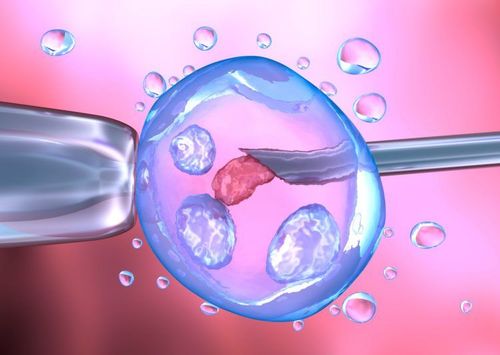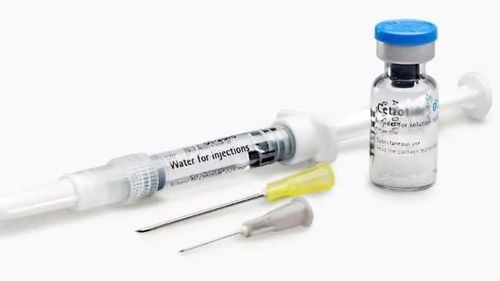This is an automatically translated article.
Ovarian hyperstimulation syndrome occurs in women who are being treated with hormonal drugs to stimulate the growth of follicles for IVF. However, when the amount of exogenous hormone drugs taken into the body exceeds the necessary level, ovarian hyperstimulation syndrome will appear. It causes extremely uncomfortable symptoms that can sometimes be life-threatening. Learning about the symptoms of ovarian hyperstimulation will help women recognize early and quickly intervene in time.
1. Symptoms of ovarian hyperstimulation are mild to moderate
When ovarian hyperstimulation syndrome is mild to moderate, especially in its early stages, symptoms may include:
Mild to moderate abdominal pain; Abdominal bloating or increased waist size; Nausea and vomiting; Diarrhea ; Pain in the lower abdomen; Sudden weight gain, more than 3 kg.

Đau bụng nhẹ đến trung bình, bụng đầy hơi và tiêu chảy là những biểu hiện nhẹ của hội chứng quá kích buồng trứng
Some women experience mild to moderate ovarian hyperstimulation as a result of the use of fertility drugs. These symptoms may improve on their own and disappear after about a week. However, if pregnancy occurs, the symptoms of ovarian hyperstimulation worsen and persist for several days to several weeks.
2. Manifestations of severe ovarian hyperstimulation
With severe ovarian hyperstimulation syndrome, a woman may have:
Rapid weight gain of 15 - 20 kg in 5 - 10 days; Severe abdominal pain; Severe nausea and vomiting; Formation of blood clots in the legs causing leg swelling; Decreased urination; Shortness of breath; The abdomen is distended.

Đau bụng nặng nề, buồn nôn và ói mửa dữ dội, bụng căng to là những biểu hiện mức độ nặng của quá kích buồng trứng
3. Signs of ovarian hyperstimulation on test
In ovarian hyperstimulation syndrome, the consistency of blood cells, mainly red blood cells (hematocrit) is the most important measure in deciding whether the patient is indicated for hospital admission or not. If the patient's hematocrit level is greater than 60% and has ascites, there is a lot of fluid in the peritoneum and pleura, immediate hospitalization is required.
At the same time, in addition to the white blood cell count, the coagulation function test kit also helps to detect hypercoagulability early and consider starting antithrombotic therapy early, preventing thromboembolic complications in patients with thrombosis. dangerous, potentially life-threatening locations such as large-scale pulmonary embolism.
Beta-hCG levels will be especially helpful 12 days after hCG injection. A positive result at this stage indicates that a woman is pregnant, which means that there is an additional source of endogenous hCG that can cause ovarian hyperstimulation syndrome. At this point, mild ovarian hyperstimulation syndrome can worsen or become really serious due to an excessive increase in hCG.
Liver function is also affected through increased expression of liver enzymes such as aspartate aminotransferase (AST), alanine aminotransferase (ALT) and alkaline phosphatase. In addition, renal function is impaired, urea and creatinine levels increase, and albumin and protein levels decrease due to losses. Not only that, patients are also at risk for electrolyte imbalance, hyperkalemia and decompensated metabolic acidosis.
Levels of estradiol when measured will also be seen to increase. Laboratory tests that detect serum estradiol levels greater than 2000 pg/mL and progesterone levels greater than 30 ng/mL during the early luteal phase are warning signs that may be present. to ovarian hyperstimulation syndrome.
Regarding the means of image evaluation, ultrasound is always the first, most popular and easy to implement tool. Ultrasound is needed to measure the size of the ovaries, evaluate the follicles, and confirm the presence of fluid in the abdomen. In addition, fluid in the pleural space is confirmed by X-ray. If the patient is tired, has a lot of difficulty breathing, sometimes it is necessary to puncture the pleura, peritoneum to remove the decompression.
In general, symptoms of ovarian hyperstimulation syndrome usually appear within 10 days of ovarian stimulation using injections. Symptoms can range from mild to severe and worsen or improve over time. These are essential information that every woman who chooses assisted reproductive technology needs to know and take precautions to help ensure a safe and successful pregnancy.
Please dial HOTLINE for more information or register for an appointment HERE. Download MyVinmec app to make appointments faster and to manage your bookings easily.
Reference source: mayoclinic.org; medlineplus.gov












